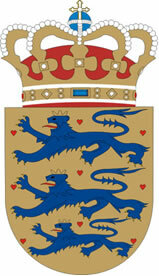Homeland of the ancient Vikings, Denmark is located in northern Europe and is the smallest of the Scandinavian countries. Danimark, according to the local language, means “land or territory of the damaged people”. Its territory is bordered by the Atlantic, bordered by Germany to the south. Denmark comprises the Jutland peninsula and 406 islands in the Baltic and Northern Seas. It has two external territories (areas belonging to the country which, however, are geographically separated), Greenland and the Faroe Islands. The largest of its islands, Zealand, is separated from Sweden by a strait whose banks shelter Copenhagen.
The nation has one of the highest Human Development Indices (HDI) in the world and an efficient social security system.
Denmark is currently ruled by Queen Margarita II and Prime Minister Anders Fogh Rasmussen.

coat of arms of Denmark
Data from Denmark:
Territorial extension: 43,077 km².
Location: Europe.
Capital: Copenhagen.
Climate: Oceanic temperate.
Government: Parliamentary monarchy.
Administrative division: 14 counties, 1 city and 1 district.
Languages: Danish.
Religion: Christianity 91.6% (Protestant 87.7%, others 3.9%), no religion 5.4%, atheism 1.5%, others 1.6%.
Population: 5,470,293 inhabitants. (Men: 2,711,537; Women: 2,758,756).
Ethnic Composition: Danes 57%, Europeans 40% (other Nordics and Germans), other 3%.
Demographic density: 126 inhab/km².
Average annual population growth rate: 0.3%.
Population residing in urban areas: 86.94%.
Population residing in rural areas: 13.06%.
Undernourished population: 3.5%.
Life expectancy at birth: 78.1 years.
Households with access to drinking water: 100%.
Households with access to a health network: 100%.
Human Development Index (HDI): 0.866 (very high).
Currency: Danish Krone.
Gross Domestic Product (GDP): US$311,596 million.
GDP per capita: 57,257 US$.
External relations: World Bank, IMF, OECD, WTO, UN, NATO, EU.
By Wagner de Cerqueira and Francisco
Graduated in Geography
Brazil School Team
Countries of the world - geography - Brazil School
